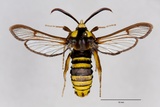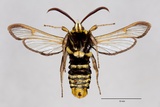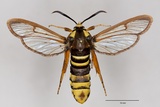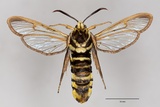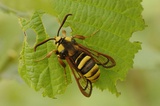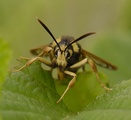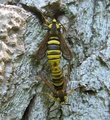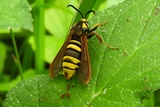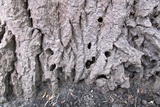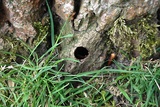Sesia apiformis (Clerck, 1759) Species
Last modified: Nov. 21, 2025, 6:13 p.m.
Very common throughout Belgium.
This species is considered Least Concern according to the IUCN Red List category for Flanders 2023.
Details
- Classification
- Family: Sesiidae > Subfamily: Sesiinae > Tribus: Sesiini > Genus: Sesia > Species: Sesia apiformis
- Vernacular names
- Hoornaarvlinder (NL), Hornet Moth (EN), Sésie du peuplier (FR), Hornissen-Glasflügler (DE)
- Synonyms
- Sesia crabroniformis (Denis & Schiffermüller, 1775)
- First mention in Belgium
- De Sélys-Longchamps E. 1837. Catalogue des Lépidoptères ou Papillons de la Belgique, précédé du tableau des Libellulines de ce pays. — — : 1–29. On page 21 (as Sesia Apiformis). view page
- Status
-
Native
Distribution
Imago
Sesia apiformis and S. bembeciformis are the largest clearwing species in Belgium, with a wingspan ranging from 30 mm to 50 mm. Females are usually considerably larger than males.Both species are very like hornets (Vespa crabro), both in appearance and behaviour. The two yellow 'epaulettes' on the thorax of S. apiformis are very striking, and distinguish this species at once from S. bembeciformis. The proboscis is strongly reduced and non-functional.
The males are strongly attracted to the pheromone developed for this species and are best lured in the morning hours till noon. It's a day-active moth.
Mine
When heavily infested, the base of the tree-trunk may show numerous emergence holes, as these remain visible for years. Except for very old ones, these exit holes are sharply delineated and have a diameter of about 1 cm. Most of these holes are located in the lower 20 cm of the trunk.
The mines always descend into the root system of the tree, making the exit hole the highest point of their gallery-system.
Cocoon/pupa
The cocoon, constructed of wood-particles spun together, is thick and strong and located below the exit hole. This is an important difference from S. bembeciformis, its closest relative, in which the cocoon is positioned above the exit hole and the pupa is oriented head down.
After hatching of the imago, the empty cocoon remains present inside the trunk behind the emergence hole for a rather long time.
Bionomics
Eggs are laid on the bark of the tree-trunk. Young larvae subsequently bore into the tree and work their way towards the root. This species hibernates two or three times as a larva. Before the final wintering, the larva prepares the future exit hole which is absolutely invisible form the outside. The cocoon is also constructed in the autumn, just underneath the thin layer of bark that conceals the exit hole and since it is positioned lower than the prepared exit hole, the pupa inside is always oriented head up.
On hatching, the pupa breaks the thin bark cover and works its way out till about half of the pupa is visible. The imago then hatches, unfolds the wings and crawls up the tree-trunk.
They are often seen resting on the tree-trunks in early morning sunshine, sometimes in copula since the females start luring males very soon after emergence.
Flight periods
The adults have been observed from mid-May till mid-August.
Habitat
S. apiformis occurs everywhere where poplar trees are growing. Typical habitats are poplar avenues, river banks, parks, ...
The only condition is that the base of the trunk must not be overgrown with other plants e.g. long grasses, nettles, brambles,... which obstruct free access of sunlight and warmth to the tree-base.
